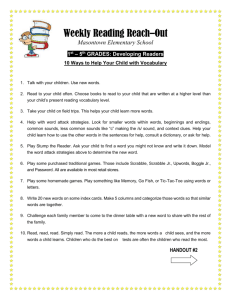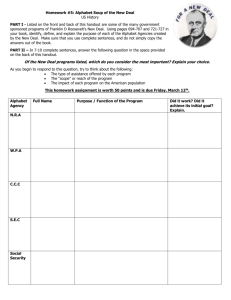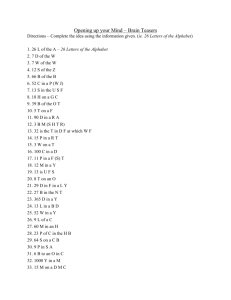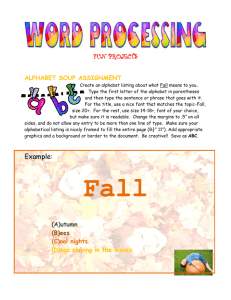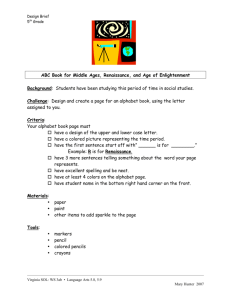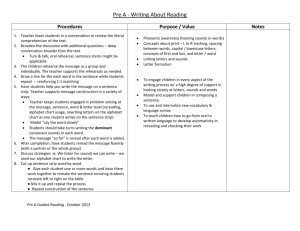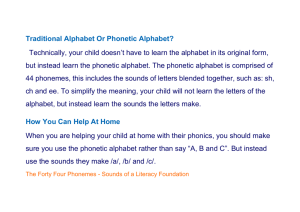Liz Hall Presentation
advertisement
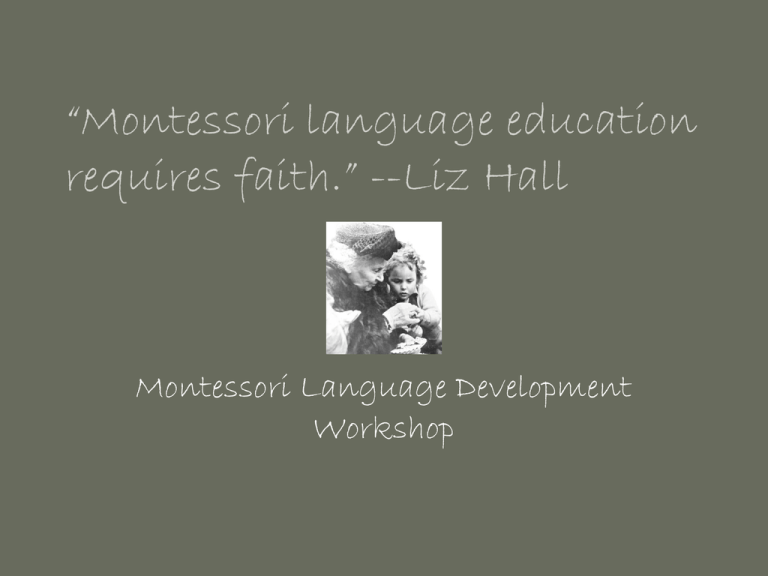
“Montessori language education requires faith.” --Liz Hall Montessori Language Development Workshop What happens when children come to the primary class at 2 ½ or 3? • He has already created a functional language that can be understood by adults other than his primary caregiver; a directress’ job is to assist the child in expanding and developing their language. • 2 ½-3 year olds should spend half of their school time on spoken language experiences. Children who join a Montessori community after or late in primary often have little or no 3-D environmental experiences due to the “cages” imposed by society: Cribs Playpens Car seats Swings Followed by the “cage” of 2-D experiences: TV Computers All day kindergarten is essential for them. Two Streams of Spoken Language: • Vocabulary Development – Words, words, words! – Concrete objects in the classroom first. – Logical groupings from general categories to more specific. • Language Training. – How words are used: • stories • poems • songs • conversations • questions and answers. Stream One: Activities for Vocabulary Development Naming the environment • Furnishings in the room. • Everything in your room must have a specific name. • Another day, do areas of the room. Word games: I Spy, the distance game, matching games and grading games. Picture Cards (3 Part Cards) • Not for picture matching! – If they are matching pictures, they aren’t building vocabulary; matching is for sensorial exploration, not the language area. • Most Montessori classrooms do not have enough sets of pictures, there should be a shelf with 15-20 sets of picture cards out at a time ~ rotated on a regular basis. • Sets of cards should be separate from the word sets; get the words out for the beginning readers • Use different sets of cards for different groups of kids: fruits w/one, veggies, animals or insects with others. • If children don’t take to language cards: – – Ask yourself, “Have they had enough experiences with the real items first?” Try using larger pictures; they are more interesting as a first step. Stream 2: Language Training • • • • • • • Told stories Read stories Longer reads (Chapter book reading) Questioning during reading Conversations Poetry – primary children love to memorize and write poetry. Self expression – I am interested in what you have to say, but NO SHOW AND TELL! If you have something of educational value, you may bring it in and present it to a small group of children. Questioning Exercise Show the children an object. Who, what, when, where and why? Ex: postcard What is this? Who sent us this postcard? When did they send it? Where did it come from? Why did they send it? Models what a conversation around a given topic looks like. Begins modeling for story writing. Objects are preferable for lessons with pictures for follow up activities. Sound Games Give sounds Beginning sounds Ending sounds Middle sounds Give the children time to answer! I Spy : “I spy with my little eye, something that starts with the sound ‘b’.” Sand Paper Letters Children must be familiar with the sounds letters make before you begin SPL; this builds interest. If you get a 4 ½ year old in your class, parallel sandpaper letters with sound games; they need the experiences, but are past the sensitive period for tactile exploration (2 ½-3 ½ yrs.) Each child gets their own letters; don’t do all letters with all kids. Presentation of SPL: Select 3 contrasting letters, preferably beginning with letters in their name. Always include a vowel so that when moveable alphabet work begins they will be able to build words. Young children should know about 15 sounds before they begin moveable alphabet work. Older students should start moveable alphabet as soon as they know 10-12 letter sounds. They are behind and need to catch up; they cannot afford to wait until they have learned 15! Moveable Alphabet Work Once it has been introduced, the moveable alphabet should be used every day. Dictate: Words (ex: “hat” - “h” “a” “t” - “h-a-t” “hat”) Try to personalize the words to the interests of the children. Short stories Cultural stories ~ “research” Personal stories Questions ~ student answers the questions with the moveable alphabet. Phonetic objects can be used for moveable alphabet work if you have a large number of carefully selected objects. Be sure to include: cvc, cvcc, ccvc and compound words Moveable alphabet increases the analytic processing of writing before children are physically able to write. Personalize language and writing as much as possible – don’t categorize the teaching of letters into groups or teach them in a sequence. Categorization of letters is for the ease of the adults, not for the benefit of the children. Primary children should be able to write short stories and read at least fifteen phonograms before they move to elementary. Reading Reading usually begins about 6 mos. after moveable alphabet writing. • Writing = 1 step analytical process. • Reading uses writing skills but requires blending and the ability to recognize it as a word he knows. • Reading is a process of synthesis that requires a certain level of intellectual maturity. • If a child can sound out the letters, but isn’t blending them, you need to go back and do more moveable alphabet work. Phonograms • Introduce the first phonograms (sh, ch, oo, th) with objects. • Object box 2: All the objects but one, presenting are completely phonetic. • Phonogram booklets • Phonogram lists • Phonogram sentences: He rushed off to the shop that sells shells. • Goal at primary level is to get all phonograms presented ~ different phonograms to different children at different times because “It is so much easier to teach these phonograms to primary children than it is to teach them to elementary children.” --Liz Hall. Word Cards • Use a set of picture cards the child has used before. • Put out the cards • Name them • Give the child the tickets to read and match This is the “drill” for word reading to get them to the point where they are almost instant. Books? • Don’t make children struggle through books; go back to word work. Children think of themselves as readers once they have read a book from cover to cover, but we don’t use books to teach children to read; they are our reading drill. We use function of words exercises (age 4-6.) The grammar symbols help a child classify each word sensorially. Function of Words Single words Nouns (girl) groups of words whole sentences Noun families Sentences (a tall girl) reading analysis. (A tall girl sat.) (action, subject, D.O., modifiers) Older Children Who Are Not Good Readers • Use beautiful literature (Owl Moon) • Read beautiful literature to a small group • Do reading analysis on sentences from the book together • Do art work about the book • Brain gym may help make-up for missed practical life and sensorial activities if a child started Montessori later in life (4 ½-6). • Books on tape can be beneficial to struggling first or second graders. Handwriting Advantages of cursive before print: Flow b, d, p & q are differentiated Helps with reading synthesis. (The flow of the letters aids this.) Whether you teach cursive or print first, both cursive and print moveable alphabets should be available. In order to write, children must be able to: • have a tension free pencil grip • form letters using lightness of touch – fabrics work (matching) – touch boards • fit letters onto uniformly sized lines • properly space letters • form letters properly – writing in all lowercase and not slipping into capitals when they can’t remember how to form lowercase.
